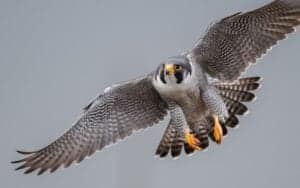Hey there, nature enthusiasts in Old Dominion! Have you ever spotted a blur of vibrant colors darting through your garden? Chances are, you’ve had a close encounter with the magnificent hummingbirds of Virginia. These feathered marvels are like no other birds you’ve seen – they’re the smallest birds in the world, but don’t let their size fool you, they’re also some of the mightiest flyers around.

Let’s dive into some of the most common Virginia hummingbirds you’ll find, as well as some of the plants that attract them.
1. Black-chinned hummingbird
The Black-Chinned hummingbird, scientifically known as Archilochus alexandri, is a captivating and colorful bird species found in several parts of the United States, including various regions of Virginia. These small yet agile birds are recognized by their shimmering green feathers and distinctive black chin, which gives them their name.
During the warmer months, typically from late spring to early fall, the Black-chinned hummingbirds are most active in the western areas of Virginia. These birds prefer mountainous terrain, where the climate and vegetation provide suitable conditions for their presence. Their agility and swift movements make them a delightful sight as they zip around flowers, shrubs, and trees in search of nectar.
To attract these charming hummingbirds to your outdoor space, consider planting an array of flowering plants that offer a rich source of nectar. The Black-Chinned hummingbirds are particularly drawn to tubular-shaped flowers such as trumpet vines, bee balm, and salvia. These blossoms not only provide nourishment in the form of nectar but also serve as convenient perches for the hummingbirds to rest and observe their surroundings.
In addition to nectar, Black-Chinned hummingbirds incorporate insects and spiders into their diet for essential protein. Their adeptness at catching insects while in flight showcases their remarkable agility and adaptability when it comes to feeding habits.
To ensure the well-being of Black-chinned hummingbirds, it’s vital to focus on habitat preservation and providing suitable food sources. By cultivating a diverse range of native flowers and refraining from using pesticides, you can contribute to the conservation of these enchanting creatures and establish a welcoming environment for them.

Black-Chinned hummingbirds are known for their violet and black “chins” or feathers under their head.
©rck_953/Shutterstock.com
2. Ruby-throated hummingbird
The Ruby-Throated hummingbird or Archilochus colubris is a dazzling and vibrant bird species that frequents various regions of the United States, including parts of Virginia. These small and agile creatures are known for their iridescent green feathers and the striking ruby-red throat patch that distinguishes them.
In Virginia, Ruby-Throated hummingbirds are highly active during the warmer months, typically from late spring to early fall. They are commonly spotted in gardens, woodlands, and areas with ample flowering plants, where they seek out nectar for sustenance.
To attract ruby-throated hummingbirds to your garden or outdoor space in Virginia, consider planting a selection of vibrant and tubular-shaped flowers. Like the Black-Chinned hummingbird, these birds are especially drawn to flowers like trumpet vines, bee balm, and cardinal flowers, which provide a bountiful supply of nectar. These blooms not only offer a nourishing food source but also serve as perches for the hummingbirds to rest between feedings.
Ruby-throated hummingbirds are primarily nectar feeders but also rely on insects and spiders for essential protein. Their agile and rapid flight patterns allow them to catch insects mid-air, showcasing their impressive hunting skills.
Maintaining a pesticide-free environment and encouraging the establishment of native blooming plants are essential for the welfare of Ruby-Throated hummingbirds. By doing this, you may help to preserve these amazing birds and make their environment more habitable.
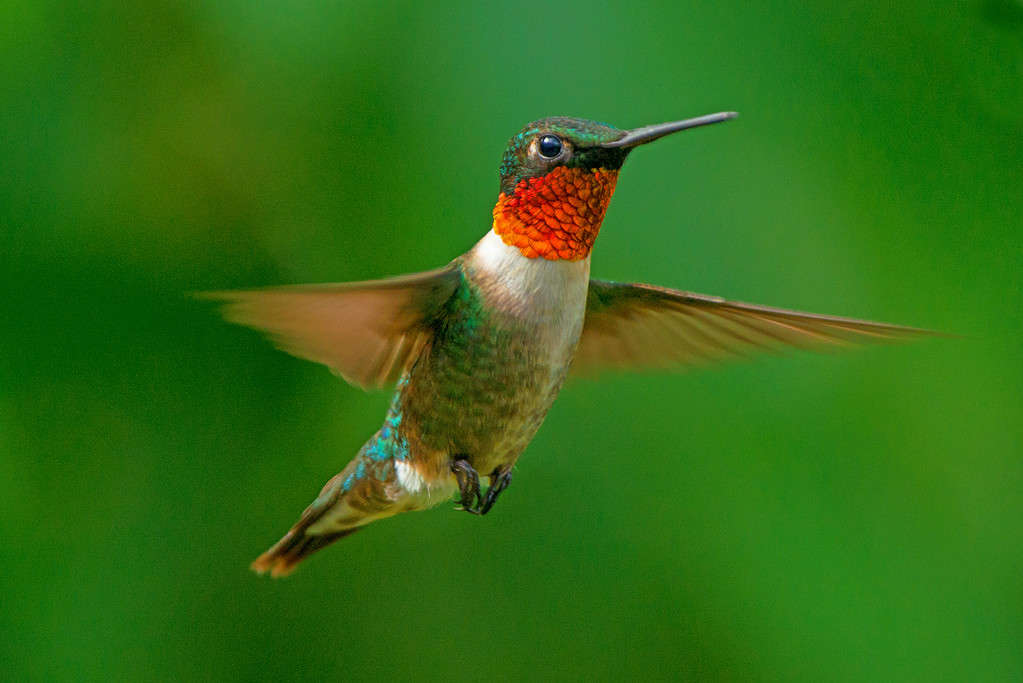
The
Ruby-Throated hummingbird
is a very common sight in Virginia.
©CarolinaBirdman/iStock via Getty Images
3. Calliope Hummingbird
Selasphorus calliope, often known as the Calliope hummingbird, is a distinctive little bird species that may be found across North America, including some areas of Virginia. The colorful plumage and distinctive traits of these little, nimble birds make them a sought-after sight for bird watchers.
The Calliope hummingbird is most active in Virginia during the warmer seasons, which are typically from late spring through early October. They are frequently seen in hilly regions, particularly in the state’s western region, where they flourish in environments with an abundance of blooming plants.
Consider putting in a range of flowering plants that provide an abundant amount of nectar if you want to draw Calliope hummingbirds to your Virginia garden or outdoor space. These birds are particularly attracted to flowers like penstemon, columbine, and scarlet gilia. These blossoms not only provide a nourishing nectar source but also offer perches for the hummingbirds to rest and survey their surroundings.
Although Calliope hummingbirds primarily feed on nectar, they also include insects and spiders in their diet to meet their protein needs. Their remarkable agility and swift movements enable them to capture insects in mid-air, highlighting their adeptness in hunting.
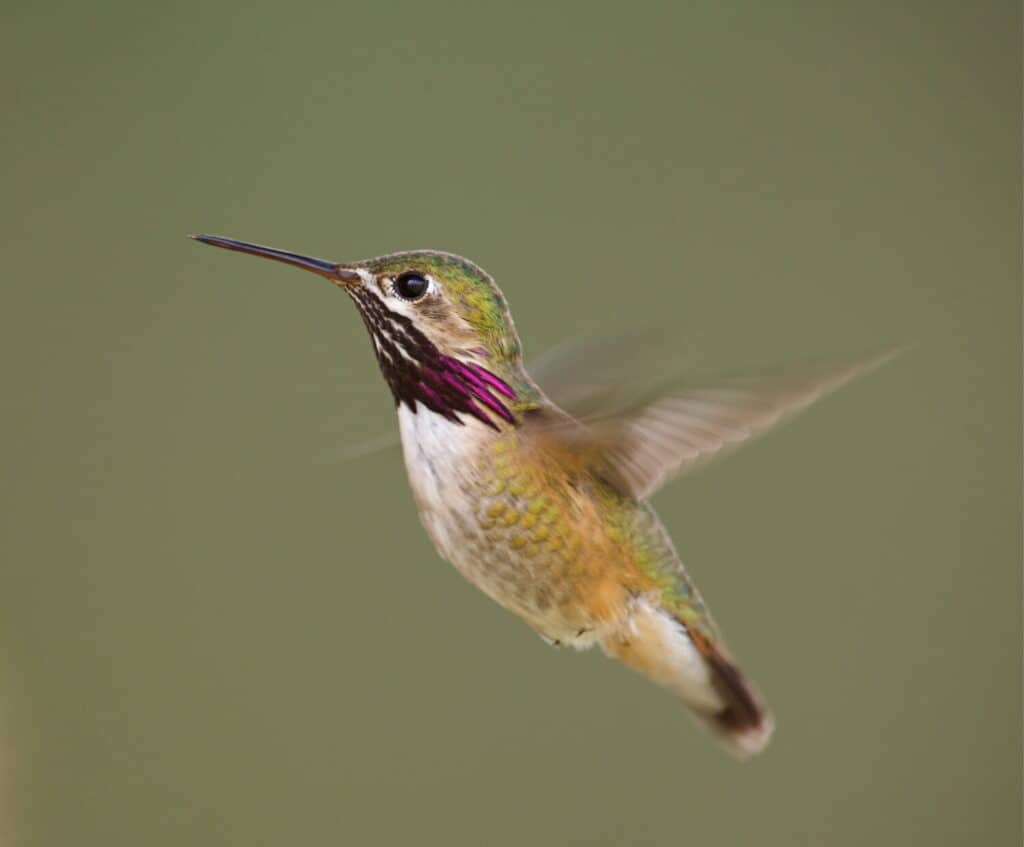
Calliope hummingbirds enjoy tubular flowers, as do the majority of hummingbird species.
©Tom Reichner/Shutterstock.com
4. Rufous Hummingbird
Selasphorus rufus, also known as the Rufous hummingbird, is a rare and remarkable bird species valued for its colorful plumage and quick flight. These little birds may be identified by their vivid orange-red back feathers, which give them a flaming look.
The breeding season for rufous hummingbirds in Virginia runs from late spring through early October. Even though they are not local, they do periodically pass through the area as they migrate. As they look for supplies of nectar to fuel their energetic flight, these birds are frequently seen in gardens, wooded areas, and other places with a lot of blooming plants.
Consider putting in several flowering plants that offer a plentiful and dependable source of nectar if you want to draw Rufous hummingbirds to your outdoor area in Virginia. These birds are particularly drawn to flowers such as trumpet vines, columbine, and coral honeysuckle. These blossoms not only offer nourishment in the form of nectar but also serve as perches for the hummingbirds to rest between feedings.
The Rufous hummingbirds’ diet primarily consists of nectar, but they also include insects and spiders in their diet for essential protein. Their swift and agile flight patterns allow them to capture insects mid-air, showcasing their impressive hunting skills. Although not permanent residents of Virginia, the presence of Rufous hummingbirds during migration adds a touch of color and liveliness to the local landscape.
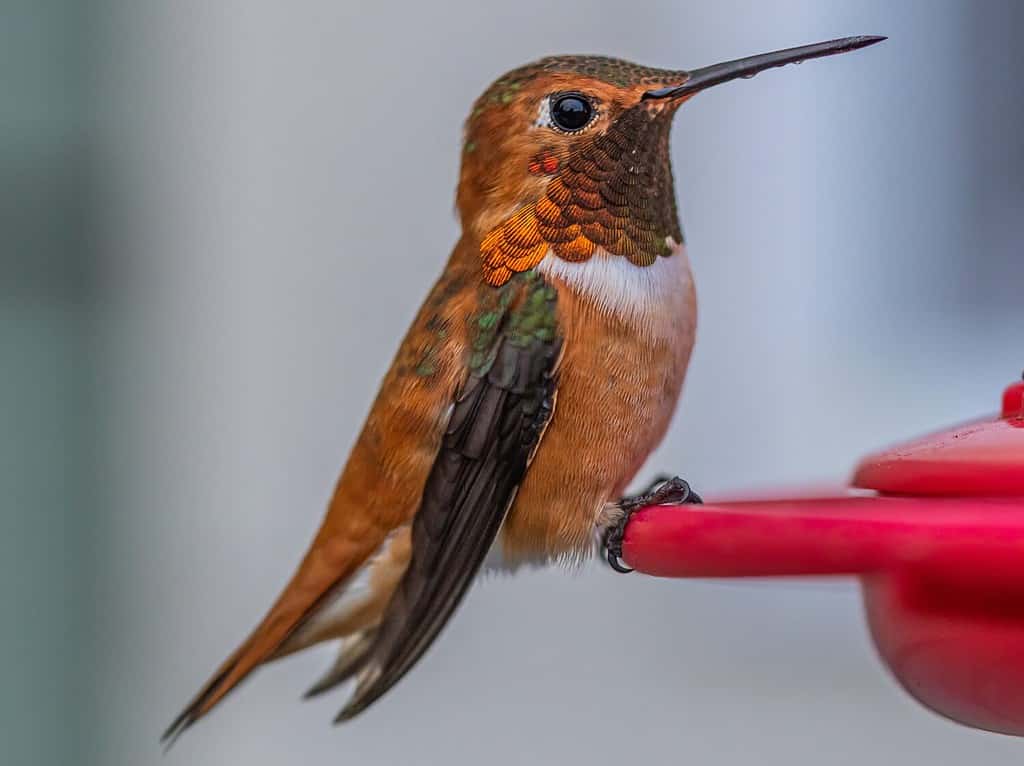
Rufous hummingbirds are a common sight in Virginia during the breeding season.
©Panduh Productions/Shutterstock.com
5. Anna’s Hummingbird
The Anna’s hummingbird or Calypte anna is a captivating and recognizable bird species known for its striking appearance and agile flight. These small creatures are easily identified by the vibrant iridescent feathers that cover their heads and throats, displaying shades of green and pink.
Although the Anna’s hummingbird is not native to Virginia, they are sometimes spotted in the state during the colder months. Their presence adds a touch of color and charm to gardens and outdoor spaces, where they actively search for sources of nectar to sustain their high-energy flight.
In Virginia, urban and suburban environments with feeders and blooming plants are where Anna’s Hummingbirds are most active. They are attracted to a range of blooms that produce nectar, including salvia, fuchsia, and coral honeysuckle. However, they are not dependent on a particular kind of flower. These blooms serve as perches for the birds to rest while also providing the vital nutrition they require.
The diet of Anna’s hummingbirds primarily consists of nectar, but they also incorporate insects and spiders into their diet for protein. Their agile flight patterns allow them to capture insects in mid-air, showcasing their impressive hunting skills.
While not permanent residents of Virginia, much like the Rufous hummingbird, the occasional appearance of Anna’s hummingbirds during the colder months adds a touch of wonder to the local environment. By setting up hummingbird feeders filled with a mixture of sugar water (one part sugar to four parts water) and creating a welcoming garden with a variety of flowering plants, you can increase the likelihood of encountering these enchanting birds.

Anna’s hummingbirds are known for their very colorful plumage.
©yhelfman/Shutterstock.com
6. Allen’s Hummingbird
The Allen’s hummingbird or Selasphorus sasin is a fun and vibrant bird species known for its dazzling appearance and energetic flight. These small yet eye-catching creatures are easily identifiable by their brilliant iridescent green feathers that cover their bodies.
While Allen’s hummingbird is not a native resident of Virginia, they occasionally make appearances in the state during their migratory journeys. Their presence adds a touch of color and charm to gardens and natural spaces, where they actively seek sources of nectar to sustain their high-energy flight.
In Virginia, the western regions of the state, particularly those with a lot of blooming plants, are where Allen’s hummingbirds are most active. They are drawn to flowers with tubular shapes like coral honeysuckle, penstemon, and columbine because they are dependable sources of nectar for them. The hummingbirds may rest on these flowers between meals in addition to providing them with food.
The diet of Allen’s hummingbirds primarily consists of nectar, but they also incorporate insects and spiders into their diet to meet their protein needs. Their rapid and agile flight patterns enable them to catch insects in mid-air, showcasing their adeptness at hunting.
The occasional presence of Allen’s hummingbirds in Virginia adds a touch of wonder to the local environment. By setting up hummingbird feeders with a solution of sugar water and cultivating a garden filled with nectar-rich flowers, you can enhance the likelihood of encountering these charming birds during their migratory journey.
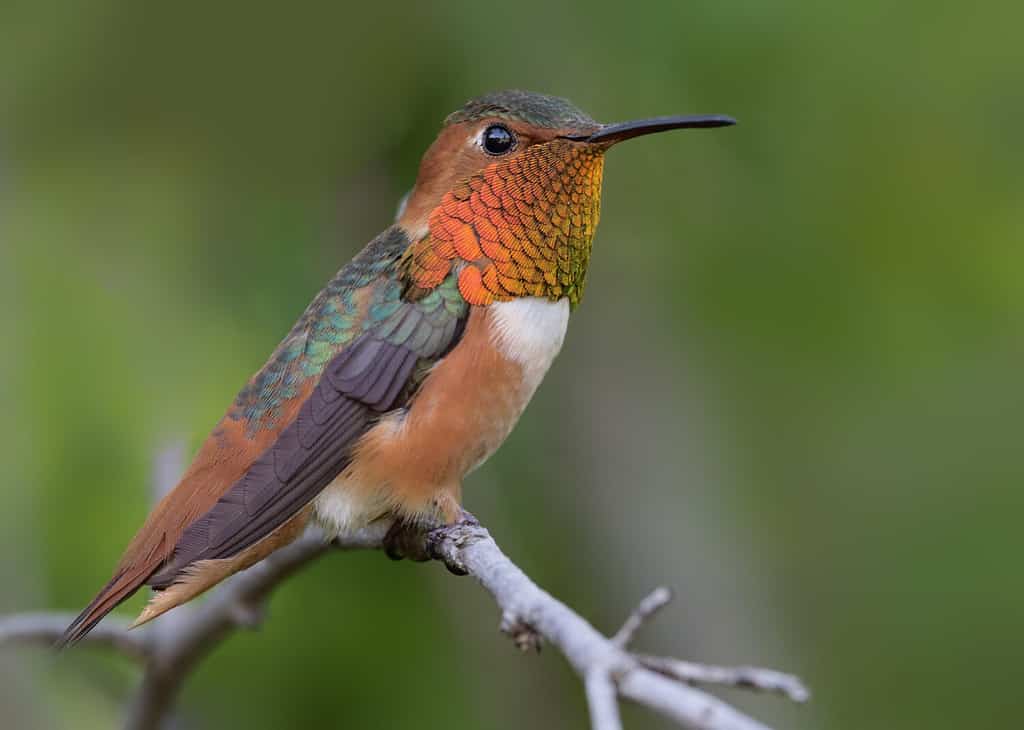
Allen’s Hummingbirds have very bright, orange, and green plumage that makes them easy to identify.
©Angel DiBilio/Shutterstock.com
7. Rivoli’s Hummingbird
The Rivoli’s hummingbird or Eugenes fulgens is a remarkable and visually striking bird species, renowned for its vivid appearance and agile aerial maneuvers. These small creatures are easily recognized by their iridescent green feathers with flashes of purple and blue, creating a captivating and shimmering display.
While the Rivoli’s hummingbird is not native to Virginia, they have been spotted occasionally during migration. These appearances bring a touch of vibrancy and wonder to gardens and natural settings, as they actively search for sources of nectar to fuel their energetic flight.
In Virginia, Rivoli’s hummingbirds are most active in the western parts of the state, particularly in areas with ample flowering plants. They are attracted to various types of flowers, including those like penstemon, trumpet vine, and columbine. These flowers provide a rich and reliable source of nectar, which is essential for their sustenance. Just as well, the flowers serve as convenient resting spots for the hummingbirds between feeding sessions.
The diet of Rivoli’s hummingbirds mainly consists of nectar, although they supplement their nutrition with insects and spiders for protein. Their rapid and skillful flight patterns enable them to catch insects while airborne, showcasing their hunting prowess.
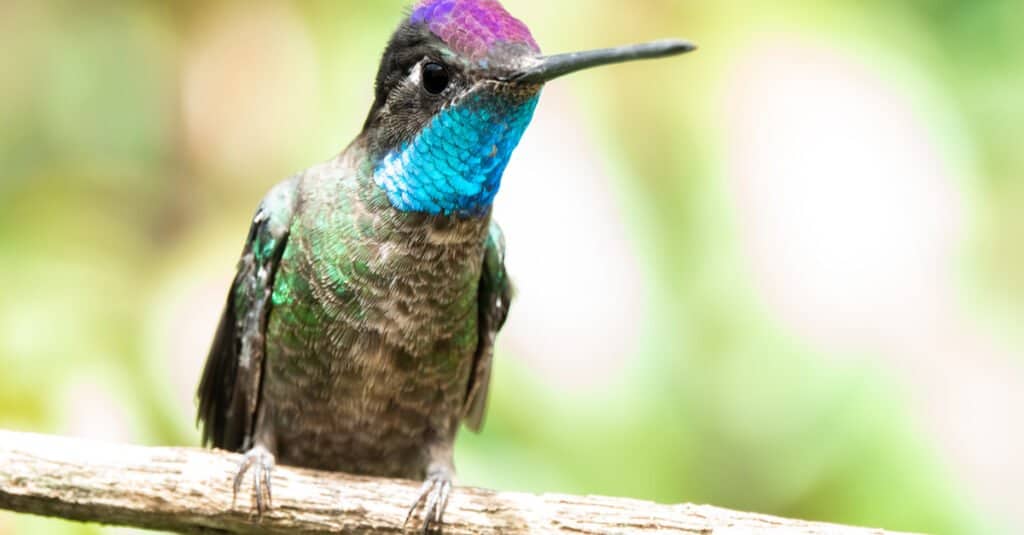
Rivoli’s hummingbirds are a bit larger than many of the hummingbirds in North America.
©Jeroen Mikkers/Shutterstock.com
Summary of 7 Hummingbird Types and Plants to Attract Them
| # | Hummingbird | Plants That Attract Them |
|---|---|---|
| 1 | Black-Chinned Hummingbird | Trumpet Vines |
| 2 | Ruby-Throated Hummingbird | Bee Balm |
| 3 | Calliope Hummingbird | Penstemon |
| 4 | Rufous Hummingbird | Coral Honeysuckle |
| 5 | Anna’s Hummingbird | Salvia |
| 6 | Allen’s Hummingbird | Columbine |
| 7 | Rivoli’s Hummingbird | Trumpet Vine |
Thank you for reading! Have some feedback for us? Contact the AZ Animals editorial team.






